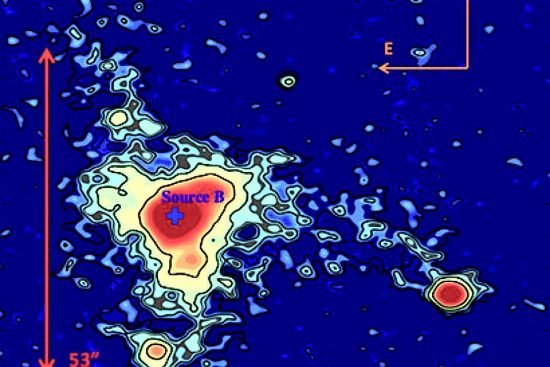
Enormous Lyman-alpha nebula (ELAN) called MAMMOTH-1. Colors and contours indicate surface brightness. Red arrows show its estimated size. Credit: Cai et al., Astrophysical Journal.
Feb 24, 2017
What is illuminating this gigantic nebula?
Astronomers from the University of California, Santa Cruz recently announced the discovery of a massive cloud of gas called an “enormous Lyman-alpha nebula” (ELAN). The “blob” of gas resides in a region of space thought to be 10 billion light-years away, and is glowing in Lyman-alpha wavelengths. A project named, Mapping the Most Massive Overdensities Through Hydrogen (MAMMOTH) gives the new ELAN its label, MAMMOTH-1.
Zheng Cai, a Hubble Postdoctoral Fellow at UC Santa Cruz said:
“Our survey was not trying to find nebulae. We’re looking for the most overdense environments in the early universe, the big cities where there are lots of galaxies. We found this enormous nebula in the middle of the protocluster, near the peak density.”
Why the name enormous Lyman-alpha nebula? What does Lyman-alpha mean? Quantum physics postulates that a hydrogen atom’s electron orbit must abide by its principal quantum number. Mathematical calculations use n = 1 for the smallest orbital radius, n = 2 for the next quantized orbital step, n = 3, and so on. As quantum physics postulates, those orbital radii must rise and fall in discrete jumps.
Since electrons are negatively charged, they are attracted to protons by their binding energy. Each “n” orbit’s binding energy is expressed in electron volts. The closer to a hydrogen atom’s nucleus, the greater the binding energy. As an electron jumps down from a higher binding energy orbit to a lower one, it emits light in the ultraviolet range. The photo emissions from the n2 to n1 jump correspond to 121.6 nanometers. This frequency band is known as “Lyman-alpha” radiation, named after Theodore Lyman.
According to the research group, MAMMOTH-1 could be shining at 121.6 nanometers because a “supermassive black hole” inside an active galactic nucleus (AGN) might be “feeding on gas in the center of a galaxy”, causing ionization in the nebular gas. Other ideas are expressed in their announcement such as, “shock heating by a powerful outflow” from the AGN.
A principal tenet of Electric Universe theory is that electrically active ionized gas, otherwise known as plasma, creates long electromagnetic filaments called Birkeland currents. Gas obeys the laws of kinetic motion, with molecules accelerated by “shock waves” or gravitational attraction. Plasma behaves according to the laws of electricity. Plasma physicists are aware that the anisotropy of an ionized gas will polarize light shining through it. Polarized emissions are sometimes used to map ionized gas and magnetic fields in discrete sources.
Previous Picture of the Day articles repeatedly affirm that when electrons are moving they are called an electric current. An electric current in a magnetic field is defined as, “field-aligned” and can release synchrotron radiation. Lyman-alpha radiation is one way that synchrotron radiation manifests.
The excitation frequency of a specific gas is a more correct model for MAMMOTH-1. Electricity passing through neon gas causes it to glow pale red. Other gases, such as oxygen, produce blue light, while heavier elements have their own colors. In the case of this cosmic blob, electrically excited hydrogen is producing an ultraviolet glare. The conclusions reached by the University’s research are assumptions based on a gravity-only cosmology.
Stephen Smith
Hat tip to William Thompson












